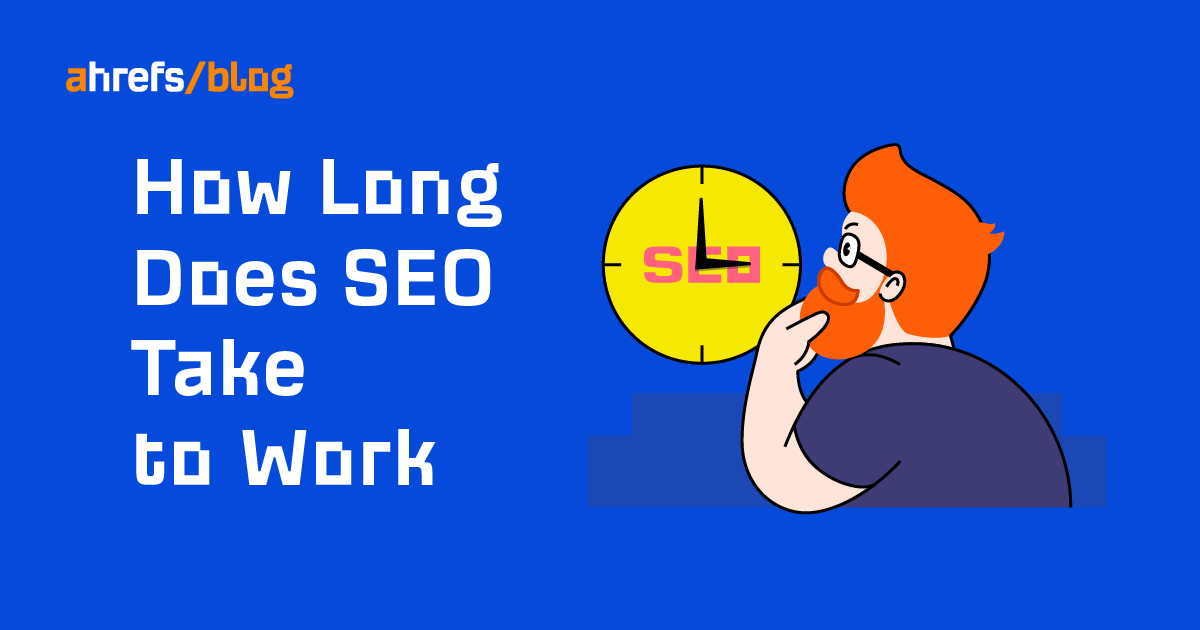SEO
How Long Does SEO Take to Show Results?

It typically takes between 3–6 months for SEO to show results.
That’s according to the ~4,300 people who responded to our polls on LinkedIn and Twitter.

Sidenote.
We also polled our customers-only Facebook group, Ahrefs Insider. Only 82 people responded there, and 6-12 months was the most popular answer.
But the reality is that there’s no definitive time frame. It depends.
Why does SEO take so long?
SEO isn’t advertising. You can’t pay your way there. So if you want to rank #1 for a keyword, you need to demonstrate to Google that you’re the best result.

That means that how long SEO takes to “work” depends on many factors. Here are some factors to consider:
1. New vs. old website
Generally speaking, since they’ve been around for longer, older websites tend to have more backlinks (and, thus, more website authority), more pages, more content, as well as rank for more keywords.
On the other hand, newer websites need more effort and resources to get off the ground. In fact, some SEOs even believe that Google has a “sandbox” that prevents new websites from ranking.
So if you’re working on a new website, it may take longer for SEO to show results.
2. The competition
SEO doesn’t exist in a bubble. Your competitors are probably doing SEO too. If the keywords you’re targeting are highly competitive, then it’s going to take you a longer time to rank.
For example, we would love to rank for the keyword “seo.” But the pages ranking for this keyword have tens of thousands of backlinks:

In fact, the Keyword Difficulty (KD) score for this keyword is a whopping 97:

If we want to compete, it’ll take us tons of time and effort. On the other hand, it’s much easier to compete for “seo for startups.” We did and now rank #1:

For reference, “seo for startups” has a medium difficulty of 22:

Recommendation
Here’s how to find keywords that are less competitive:
- Enter a relevant keyword into Ahrefs’ Keywords Explorer
- Go to the Matching terms report
- Set a KD filter to a maximum of 20 (or a number you’re comfortable with)

3. Your resources
The more resources you can dedicate and invest in SEO, the “faster” your results will be.
For example, you could hire more content writers to create high-quality content for you. Or you could invest in SEO tools and make your work easier, faster, and more efficient. You might even be able to create a link building team to actively build links for you. The possibilities are endless.
4. Your strategy
A good strategy is half the battle won.
If you have a detailed plan on how you’ll like to tackle your target keywords, you’ll have a higher chance of achieving faster results.
For example, you may have a bunch of important keywords you’ll like to rank for. However, they’re all super competitive. So if you’re investing all your resources into trying to rank for these keywords, it may take months or even years before you see any results.
Alternatively, you can build up slowly to your most important keywords by first targeting low-competition topics that have business value. That way, you can still generate some organic traffic to your site—while accumulating links, website authority, and more for the future.
Recommended reading: The Insanely Simple SEO Strategy for 2022 (The Orchard Strategy)
5. Your execution
To win the other half of the battle, you’ll have to actually execute.
There’s no point in dreaming up the greatest SEO strategy in the world if nothing gets done. Likewise, if you constantly have to justify to internal stakeholders whether SEO is worth the effort, that may hinder your efforts to execute.
So the more consistently you execute, the “faster” you’ll likely see results.
Recommended reading: How to Set the Right SEO Goals With 3 Examples
Learn more
Want to learn more about SEO? Check out these resources:
SEO
Google Declares It The “Gemini Era” As Revenue Grows 15%

Alphabet Inc., Google’s parent company, announced its first quarter 2024 financial results today.
While Google reported double-digit growth in key revenue areas, the focus was on its AI developments, dubbed the “Gemini era” by CEO Sundar Pichai.
The Numbers: 15% Revenue Growth, Operating Margins Expand
Alphabet reported Q1 revenues of $80.5 billion, a 15% increase year-over-year, exceeding Wall Street’s projections.
Net income was $23.7 billion, with diluted earnings per share of $1.89. Operating margins expanded to 32%, up from 25% in the prior year.
Ruth Porat, Alphabet’s President and CFO, stated:
“Our strong financial results reflect revenue strength across the company and ongoing efforts to durably reengineer our cost base.”
Google’s core advertising units, such as Search and YouTube, drove growth. Google advertising revenues hit $61.7 billion for the quarter.
The Cloud division also maintained momentum, with revenues of $9.6 billion, up 28% year-over-year.
Pichai highlighted that YouTube and Cloud are expected to exit 2024 at a combined $100 billion annual revenue run rate.
Generative AI Integration in Search
Google experimented with AI-powered features in Search Labs before recently introducing AI overviews into the main search results page.
Regarding the gradual rollout, Pichai states:
“We are being measured in how we do this, focusing on areas where gen AI can improve the Search experience, while also prioritizing traffic to websites and merchants.”
Pichai reports that Google’s generative AI features have answered over a billion queries already:
“We’ve already served billions of queries with our generative AI features. It’s enabling people to access new information, to ask questions in new ways, and to ask more complex questions.”
Google reports increased Search usage and user satisfaction among those interacting with the new AI overview results.
The company also highlighted its “Circle to Search” feature on Android, which allows users to circle objects on their screen or in videos to get instant AI-powered answers via Google Lens.
Reorganizing For The “Gemini Era”
As part of the AI roadmap, Alphabet is consolidating all teams building AI models under the Google DeepMind umbrella.
Pichai revealed that, through hardware and software improvements, the company has reduced machine costs associated with its generative AI search results by 80% over the past year.
He states:
“Our data centers are some of the most high-performing, secure, reliable and efficient in the world. We’ve developed new AI models and algorithms that are more than one hundred times more efficient than they were 18 months ago.
How Will Google Make Money With AI?
Alphabet sees opportunities to monetize AI through its advertising products, Cloud offerings, and subscription services.
Google is integrating Gemini into ad products like Performance Max. The company’s Cloud division is bringing “the best of Google AI” to enterprise customers worldwide.
Google One, the company’s subscription service, surpassed 100 million paid subscribers in Q1 and introduced a new premium plan featuring advanced generative AI capabilities powered by Gemini models.
Future Outlook
Pichai outlined six key advantages positioning Alphabet to lead the “next wave of AI innovation”:
- Research leadership in AI breakthroughs like the multimodal Gemini model
- Robust AI infrastructure and custom TPU chips
- Integrating generative AI into Search to enhance the user experience
- A global product footprint reaching billions
- Streamlined teams and improved execution velocity
- Multiple revenue streams to monetize AI through advertising and cloud
With upcoming events like Google I/O and Google Marketing Live, the company is expected to share further updates on its AI initiatives and product roadmap.
Featured Image: Sergei Elagin/Shutterstock
SEO
brightonSEO Live Blog

Hello everyone. It’s April again, so I’m back in Brighton for another two days of Being the introvert I am, my idea of fun isn’t hanging around our booth all day explaining we’ve run out of t-shirts (seriously, you need to be fast if you want swag!). So I decided to do something useful and live-blog the event instead.
Follow below for talk takeaways and (very) mildly humorous commentary. sun, sea, and SEO!
SEO
Google Further Postpones Third-Party Cookie Deprecation In Chrome

Google has again delayed its plan to phase out third-party cookies in the Chrome web browser. The latest postponement comes after ongoing challenges in reconciling feedback from industry stakeholders and regulators.
The announcement was made in Google and the UK’s Competition and Markets Authority (CMA) joint quarterly report on the Privacy Sandbox initiative, scheduled for release on April 26.
Chrome’s Third-Party Cookie Phaseout Pushed To 2025
Google states it “will not complete third-party cookie deprecation during the second half of Q4” this year as planned.
Instead, the tech giant aims to begin deprecating third-party cookies in Chrome “starting early next year,” assuming an agreement can be reached with the CMA and the UK’s Information Commissioner’s Office (ICO).
The statement reads:
“We recognize that there are ongoing challenges related to reconciling divergent feedback from the industry, regulators and developers, and will continue to engage closely with the entire ecosystem. It’s also critical that the CMA has sufficient time to review all evidence, including results from industry tests, which the CMA has asked market participants to provide by the end of June.”
Continued Engagement With Regulators
Google reiterated its commitment to “engaging closely with the CMA and ICO” throughout the process and hopes to conclude discussions this year.
This marks the third delay to Google’s plan to deprecate third-party cookies, initially aiming for a Q3 2023 phaseout before pushing it back to late 2024.
The postponements reflect the challenges in transitioning away from cross-site user tracking while balancing privacy and advertiser interests.
Transition Period & Impact
In January, Chrome began restricting third-party cookie access for 1% of users globally. This percentage was expected to gradually increase until 100% of users were covered by Q3 2024.
However, the latest delay gives websites and services more time to migrate away from third-party cookie dependencies through Google’s limited “deprecation trials” program.
The trials offer temporary cookie access extensions until December 27, 2024, for non-advertising use cases that can demonstrate direct user impact and functional breakage.
While easing the transition, the trials have strict eligibility rules. Advertising-related services are ineligible, and origins matching known ad-related domains are rejected.
Google states the program aims to address functional issues rather than relieve general data collection inconveniences.
Publisher & Advertiser Implications
The repeated delays highlight the potential disruption for digital publishers and advertisers relying on third-party cookie tracking.
Industry groups have raised concerns that restricting cross-site tracking could push websites toward more opaque privacy-invasive practices.
However, privacy advocates view the phaseout as crucial in preventing covert user profiling across the web.
With the latest postponement, all parties have more time to prepare for the eventual loss of third-party cookies and adopt Google’s proposed Privacy Sandbox APIs as replacements.
Featured Image: Novikov Aleksey/Shutterstock
-
SEARCHENGINES6 days ago
Daily Search Forum Recap: April 19, 2024
-

 WORDPRESS7 days ago
WORDPRESS7 days agoHow to Make $5000 of Passive Income Every Month in WordPress
-

 WORDPRESS6 days ago
WORDPRESS6 days ago13 Best HubSpot Alternatives for 2024 (Free + Paid)
-

 MARKETING6 days ago
MARKETING6 days agoBattling for Attention in the 2024 Election Year Media Frenzy
-

 WORDPRESS6 days ago
WORDPRESS6 days ago7 Best WooCommerce Points and Rewards Plugins (Free & Paid)
-

 AFFILIATE MARKETING7 days ago
AFFILIATE MARKETING7 days agoAI Will Transform the Workplace. Here’s How HR Can Prepare for It.
-

 SEO6 days ago
SEO6 days agoGoogle Answers Whether Having Two Sites Affects Rankings
-

 MARKETING5 days ago
MARKETING5 days agoAdvertising in local markets: A playbook for success
















You must be logged in to post a comment Login